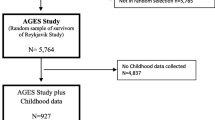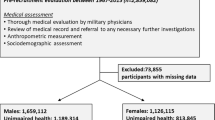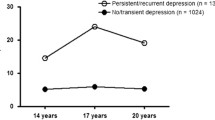Abstract
Adolescence represents an important period in brain and mental development, which raises the question of whether measures of body size at entry into adult life influence the risk of developing mood disorders. We examined the association of BMI and height in a cohort of young men with risk of mood disorders throughout life. The study included 630,807 Danish men born 1939–1959 and 1983–1997 with measures of height and weight at conscription board examinations. Psychiatrist’s diagnosis of mood disorders was obtained from national patient registries from 1969 to 2016. The associations of BMI and height with mood disorders were estimated by Cox proportional hazard regression analyses adjusting for education, cognitive ability, migration status drug and alcohol misuse. During a mean follow-up of 26.3 years, 2,608 (0.6%) and 19,690 (3.1%) men were diagnosed with bipolar disorder and depression, respectively. We found an inverse linear association of BMI with risk of bipolar disorder, whereas the association of BMI with depression was curve-linear with a decline in risk until BMI around 25 kg/m2, and an almost constant risk across the BMI range above 25 kg/m2. Height was not associated with bipolar disorder or depression. Comparison of brothers, assumed to share family factors of possible influence on the risk of mood disorders, showed similar results although with wider confidence intervals. BMI in the lower range at men’s entry into adulthood is inversely associated with risk of bipolar disorder and depression throughout adult life, whereas height is not related.


Similar content being viewed by others
Data availability
The data that support the findings of this study are available from Statistics Denmark. Restrictions apply to the availability of the data that were used under license for this study. Data are available from Statistics Denmark with the permission of the scientific board of the Danish Conscription Database.
References
Jung SJ, Woo H-T, Cho S, Park K, Jeong S, Lee YJ, et al. Association between body size, weight change and depression: systematic review and meta-analysis. Br J Psychiatry J Ment Sci. 2017;211:14–21.
Kretschmer E. An investigation of the Nature of Constitution and the theory of temperament. London: Routhledge 1925
Luppino FS. Overweight, obesity, and depression: a systematic review and meta-analysis of longitudinal studies. Arch Gen Psychiatry. 2010;67:220–9.
Pereira-Miranda E, Costa PRF, Queiroz VAO, Pereira-Santos M, Santana MLP. Overweight and Obesity Associated with Higher Depression Prevalence in Adults: A Systematic Review and Meta-Analysis. J Am Coll Nutr. 2017;36:223–33.
de Wit LM, van Straten A, van Herten M, Penninx BWJH, Cuijpers P. Depression and body mass index, a u-shaped association. BMC Public Health. 2009;9:14.
Lee J-H, Park SK, Ryoo J-H, Oh C-M, Choi J-M, McIntyre RS, et al. U-shaped relationship between depression and body mass index in the Korean adults. Eur Psychiatry J Assoc Eur Psychiatr. 2017;45:72–80.
Hiyoshi A, Sabet JA, Sjöqvist H, Melinder C, Brummer RJ, Montgomery S. Precursors in adolescence of adult-onset bipolar disorder. J Affect Disord. 2017;218:353–8.
Anderson SE, Cohen P, Naumova EN, Jacques PF, Must A. Adolescent obesity and risk for subsequent major depressive disorder and anxiety disorder: prospective evidence. Psychosom Med. 2007;69:740–7.
McElroy SL, Keck PE. Obesity in bipolar disorder: an overview. Curr Psychiatry Rep. 2012;14:650–8.
Batty GD, Whitley E, Kivimäki M, Tynelius P, Rasmussen F. Body mass index and attempted suicide: Cohort study of 1,133,019 Swedish men. Am J Epidemiol. 2010;172:890–9.
Magnusson PKE, Gunnell D, Tynelius P, Davey Smith G, Rasmussen F. Strong inverse association between height and suicide in a large cohort of Swedish men: evidence of early life origins of suicidal behavior? Am J Psychiatry. 2005;162:1373–5.
Gafoor R, Booth HP, Gulliford MC. Antidepressant utilisation and incidence of weight gain during 10 years’ follow-up: population based cohort study. Bmj. 2018;361:k1951.
Vittengl JR. Which body shape dimensions and sizes predict depression? J Affect Disord. 2019;250:193–8.
Steinberg L. Cognitive and affective development in adolescence. Trends Cogn Sci. 2005;9:69–74.
Christensen GT, Skogstad S, Nissen LR, Osler M. Data resource profile: danish conscription registry data (DCRD). Int J Epidemiol. 2018;47(4):1023–4.
WHO Consultation on Obesity. (1997: Geneva S, Diseases WHOD. of N, World Health Organization. Programme of Nutrition F and RH. Obesity: preventing and managing the global epidemic : report of a WHO Consultation on Obesity, Geneva, 3–5 June 1997. 1998 [cited 2019 Jun 15]; Available from: https://apps.who.int/iris/handle/10665/63854.
Thygesen LC, Daasnes C, Thaulow I, Bronnum-Hansen H. Introduction to Danish (nationwide) registers on health and social issues: structure, access, legislation, and archiving. Scand J Public Health. 2011;39:12–6.
Christensen GT, Rozing MP, Mortensen EL, Christensen K, Osler M. Young adult cognitive ability and subsequent major depression in a cohort of 666,804 Danish men. J Affect Disord. 2018;235:162–7.
Jané-Llopis E, Matytsina I. Mental health and alcohol, drugs and tobacco: a review of the comorbidity between mental disorders and the use of alcohol, tobacco and illicit drugs. Drug Alcohol Rev. 2006;25:515–36.
Holt JD, Prentice RL. Survival analyses in twin studies and matched pair experiments. Biometrika. 1974;61:17–30.
Kessing L. Validity of diagnoses and other clinical register data in patients with affective disorder. Eur Psychiatry. 1998;13:392–8.
Henriksson S, Boëthius G, Håkansson J, Isacsson G. Indications for and outcome of antidepressant medication in a general population: a prescription database and medical record study, in Jämtland county, Sweden, 1995. Acta Psychiatr Scand. 2003;108:427–31.
Austin PC, Lee DS, Fine JP. Introduction to the analysis of survival data in the presence of competing risks. Circulation. 2016;133:601–9.
Geoffroy M-C, Li L, Power C. Depressive symptoms and body mass index: co-morbidity and direction of association in a British birth cohort followed over 50 years. Psychol Med. 2014;44:2641–52.
Lawson EA, Miller KK, Blum JI, Meenaghan E, Misra M, Eddy KT, et al. Leptin levels are associated with decreased depressive symptoms in women across the weight spectrum, independent of body fat. Clin Endocrinol (Oxf). 2012;76:520–5.
Nead KT. Androgens and depression: a review and update. Curr Opin Endocrinol Diabetes Obes. 2019;26:175–9.
Bjerkeset O, Romundstad P, Evans J, Gunnell D. Association of adult body mass index and height with anxiety, depression, and suicide in the general population: the HUNT study. Am J Epidemiol. 2008;167:193–202.
Jokela M, Berg V, Silventoinen K, Batty GD, Singh-Manoux A, Kaprio J, et al. Body mass index and depressive symptoms: testing for adverse and protective associations in two twin cohort studies. Twin Res Hum Genet Off J Int Soc Twin Stud. 2016;19:306–11.
Bahrami S, Steen NE, Shadrin A, O’Connell K, Frei O, Bettella F, et al. Shared genetic Loci between body mass index and major psychiatric disorders: a genome-wide association study. JAMA Psychiatry. 2020;77:503–12.
Funding
The work was supported by the Danish Medical Research Council [Grant number 09-063599 and 09-069151], the Velux Foundation [Grant number 31205], the Jascha Foundation, the Health Foundation (17-B-0033), and the Doctor Sofus Carl Emil Friis and Olga Doris Friis grant.
Author information
Authors and Affiliations
Contributions
All authors were involved in study design and participated in discussing the progress of analyses and the interpretation of findings. GTO and MO conducted the analyses and wrote the first draft of the manuscript. All authors were involved in the drafting of the manuscript and revision for intellectual content, approved the final version before publication, and agree to be held accountable for the work. MO is the guarantor for the data and the analyses.
Corresponding author
Ethics declarations
Conflict of interest
The authors that they have declare no conflict if interest.
Additional information
Publisher’s Note
Springer Nature remains neutral with regard to jurisdictional claims in published maps and institutional affiliations.
Supplementary Information
Below is the link to the electronic supplementary material.
Rights and permissions
About this article
Cite this article
Okholm, G.T., Jørgensen, T.S.H., Rozing, M.P. et al. Body mass index and height in young adult men in relation to subsequent risk of mood disorder. Eur J Epidemiol 36, 1065–1074 (2021). https://doi.org/10.1007/s10654-021-00783-z
Received:
Accepted:
Published:
Issue Date:
DOI: https://doi.org/10.1007/s10654-021-00783-z




